Arc Fault Circuit Interrupter (AFCI) Protection
AFCI Protection Is Needed In Your San Antonio Area Home - Arc Fault Circuit Interrupters (AFCI's) in your San Antonio area home are special types of electrical receptacles or outlets and circuit breakers designed to detect and respond to potentially dangerous electrical arcs in home branch wiring. Initially AFCIs were introduced in the late 1990s, and detected exclusively parallel arcs, or current that travels from one circuit conductor to another. They were followed more recently by combination AFCIs, which respond to both parallel and series arcs, the latter of which occurs when a single conductor is severed and current travels across the compromised point. Starting January 1, 2008 combination AFCIs for all 120-V, 15- and 20-A branch circuits that supply bedroom outlets in new homes, which generally includes receptacle outlets, lighting outlets and smoke alarm outlets were required. Since then the requirements now call for combination AFCIs beyond bedroom circuits to include other areas in the home, such as family rooms, studies, dining rooms, living rooms, closets and hallways. This is basically meaning that all non GFCI areas are now required to be AFCI protected. The newer requirements are being adopted and followed by most San Antonio area jurisdictions. It is important to distinguish AFCI devices from Ground Fault Circuit Interrupter (GFCI) devices. GFCIs detect ground faults, which occur when current leaks from a hot (ungrounded) conductor to a grounded object as a result of a short-circuit. This situation can be hazardous when a person unintentionally becomes the current’s path to the ground. GFCIs function by constantly monitoring the current flow between hot and neutral (grounding) conductors, and activate when they sense a difference of 5 milliamps or more. Thus, GFCIs are intended to prevent personal injury due to electric shock, while AFCIs prevent personal injury and property damage due to structure fires. There are several ways an arc fault can occur- Any of the above scenarios can result in a parallel or series arc. A parallel arc can occur if the insulation on an appliance cord is pierced by a nail or screw on the two current-carrying conductors at the same point, allowing current to travel between the conductors that are now slightly gapped. Conversely, a series arc can occur when a single conductor is severed; for example, if one conductor on a cord is cut or broken completely and current continues to flow in the slight gap between the two compromised points. When an electric current crosses an air gap from an energized component to a grounded component, it produces According to the National Fire Protection Agency for the year 2005, electrical fires damaged approximately 20,900 homes, killed 500 people, and cost $862 million in property damage. In conclusion, AFCI’s are designed to protect you in your San Antonio area home by detecting small arcs of electricity before they have a chance to start a fire by tripping the breaker that is usually located in the garage sub panel. ' By Joe Keresztury, Contributing info and/or photos by: InterNACHI and IAEI Magazine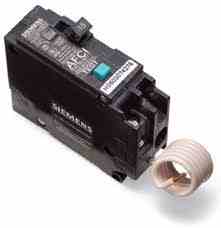 An AFCI circuit breaker protects branch-circuit wiring from arcing faults that could start an electrical fire. An arc fault occurs when current flows in an unintended path, and the heat generated at the point of the arc (up to 10,000° F) can set fire to insulation or wood framing.
An AFCI circuit breaker protects branch-circuit wiring from arcing faults that could start an electrical fire. An arc fault occurs when current flows in an unintended path, and the heat generated at the point of the arc (up to 10,000° F) can set fire to insulation or wood framing.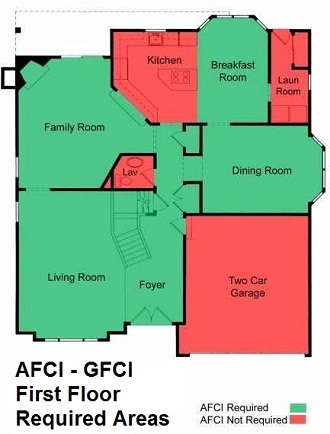
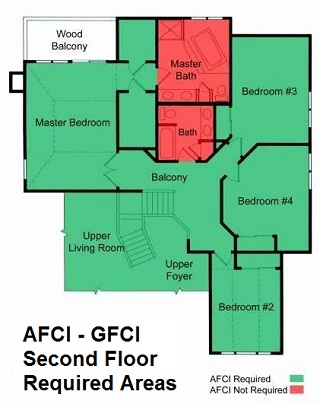
Images show AFCI (green shaded) and GFCI (red shaded) required areas on a 2 story home. Note: This layout for requirements is for inside of home only as GFCI's are also required at all exterior outlets. See more info for GFCI's @: http://www.jwkhomeinspections.com/GFCI-Ground-Fault-Circuit-Interrupter-san-antonio-home-inspectors-blog.html
- Improper installation or puncturing of a wire with a screw, nail, staple or a tool during installation or maintenance of the electrical system. 
- Damaging of an electrical wire during tasks like hanging pictures or installing cabinets.
- Damaging of extension or appliance cords by vacuum cleaners, doors furniture or an appliance has been positioned on the cord.
- Advanced age of extension or appliance cords, or even wiring in the walls which can over time experience worn or cracked insulation.
- loose connections in outlets, switches and light fixtures.
- appliance cords damaged by heat, kinking, impact or over-extension, spillage of liquid.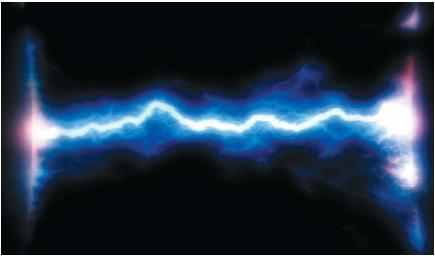 a glowing plasma discharge known as an arc. For example, a bolt of lightning is a very large, powerful arc that crosses an atmospheric gap from an electrically charged cloud to the ground or another cloud. Just as lightning can cause fires, arcs produced by the wiring in your home are capable of producing high levels of heat that can ignite the surroundings materials and lead to structure fires.
a glowing plasma discharge known as an arc. For example, a bolt of lightning is a very large, powerful arc that crosses an atmospheric gap from an electrically charged cloud to the ground or another cloud. Just as lightning can cause fires, arcs produced by the wiring in your home are capable of producing high levels of heat that can ignite the surroundings materials and lead to structure fires. Although short-circuits and overloads account for many of these fires, arcs are responsible for the majority and are undetectable by traditional (non-AFCI) circuit breakers.
Although short-circuits and overloads account for many of these fires, arcs are responsible for the majority and are undetectable by traditional (non-AFCI) circuit breakers.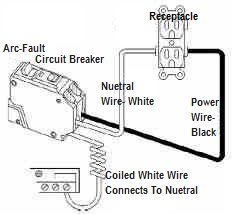 AFCIs function by monitoring the electrical waveform and promptly opening -interrupting the circuit they serve if they detect changes in the wave pattern that are characteristic of a dangerous arc. They should be capable of distinguishing safe, normal arcs, such as those created when a switch is turned on or a plug is pulled from a receptacle, from arcs that can cause fires. An AFCI can detect, recognize, and respond to very small changes in wave pattern.
AFCIs function by monitoring the electrical waveform and promptly opening -interrupting the circuit they serve if they detect changes in the wave pattern that are characteristic of a dangerous arc. They should be capable of distinguishing safe, normal arcs, such as those created when a switch is turned on or a plug is pulled from a receptacle, from arcs that can cause fires. An AFCI can detect, recognize, and respond to very small changes in wave pattern.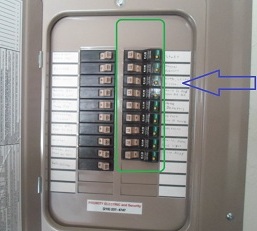 Photo shows a garage subpanel at a recent San Antonio New Home inspection with the AFCI breakers as required.
Photo shows a garage subpanel at a recent San Antonio New Home inspection with the AFCI breakers as required.
JWK Inspections
San Antonio Home Inspector, Consultant & New Home Construction Specialist





















Post new comment